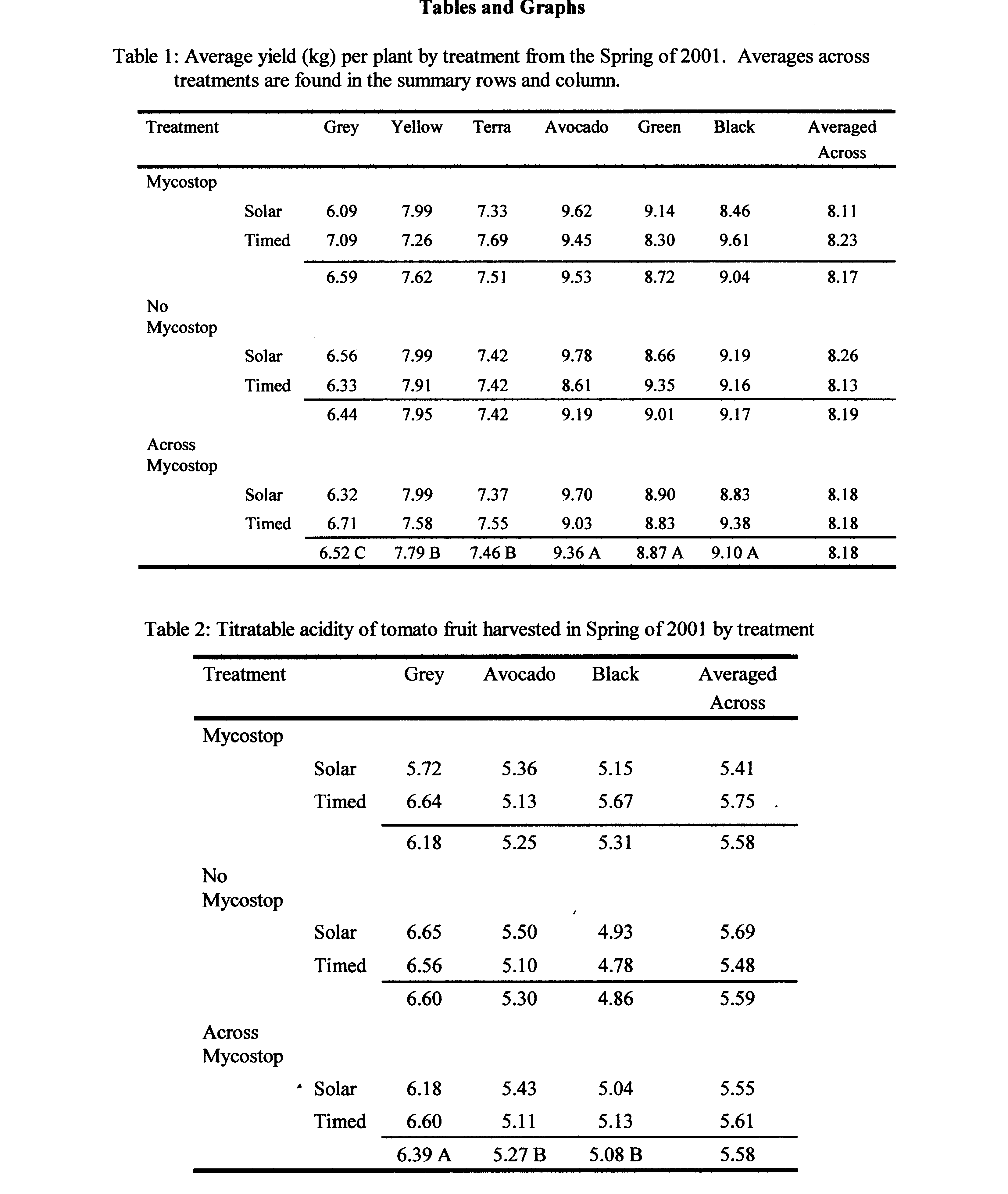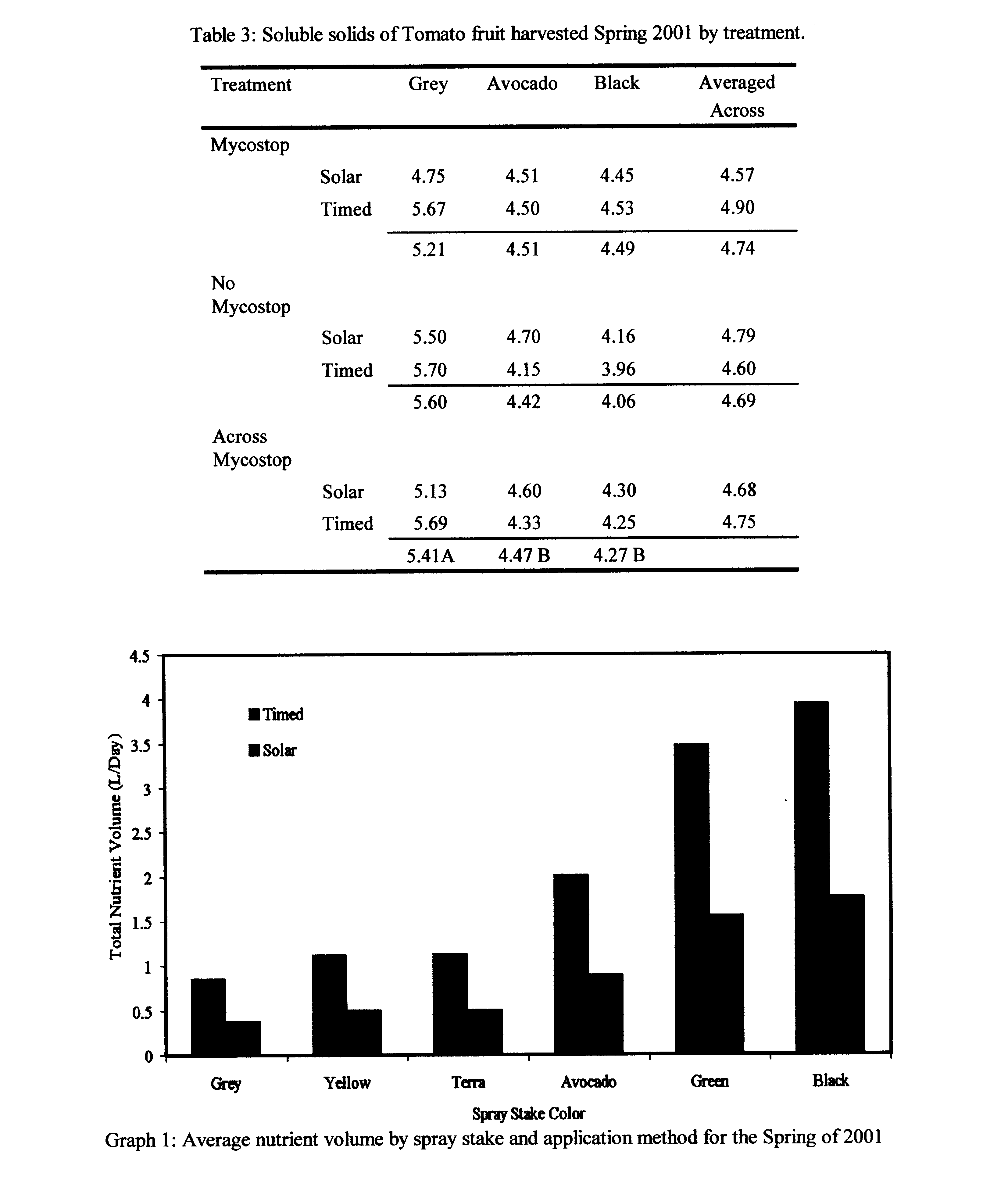Optimizing yield and post-harvest fruit quality: The effects of MycostopTM, nutrient volume, and irrigation regulated by a solar irradiation based irrigation controller (Solar-Gro12TM) on hydroponic greenhouse tomatoes.
J. L. Warren, S. G. Harvey, H. D. Toler and C. E. Sams
Interpretive Summary
In this experiment (in the absences of disease pressure) the application of Mycostop had no effect on yield or quality of fruit harvested. Nutrient and irrigation application based on the amount of solar radiation received by the crop reduced the amount of nutrient used without reducing yield or quality. Fruit quality was higher with lower amounts of irrigation but yield increased with increased irrigation. About 2L per day was adequate to produce good yield without reducing quality in these experiments.
Introduction
Greenhouse production of tomatoes is a viable, growing industry in East Tennessee. However, in-ground greenhouse systems can quickly become unprofitable due to the increased levels of soil disease pressure. Ideally, hydroponic systems could improve on in ground greenhouse systems by eliminating soil disease problems and optimizing nutrients available to the plant which would increase profitability of greenhouse grown tomatoes by boosting yields per plant. There is still some uncertainty as to how much nutrient solution is sufficient for optimum growth. Growers generally apply excessive solution to tomato plants in hydroponic systems and though their yields are high, they waste nutrients, water, and money. Also, fruit quality can be decreased when tomato plants receive exorbitant supplies of nutrients and water, producing tomatoes generally lacking in flavor.
Occasionally, hydroponic systems will have disease pressure from root pathogens. One way to reduce disease incidence is to apply a biocontrol organism, which can occupy the root zone and deprive pathogens of living space and nutrients. Mycostop® , a biofungicide, contains the dried spores and mycelium of the ray fungus, Streptomyces griseoviridis (Strain K61). It has been claimed that Mycostop® can increase yields by 5-15% even in healthy plants. If this is the case, it may prove to be cost effective to growers to use this biofungicide, decrease fertilizer application, and prevent potential pest outbreaks.
An experiment was designed to determine the optimum nutrient availability, and potentially improve fruit quality by manipulating the amount and method of application of nutrient solution and applying Mycostop®.
Materials and Methods
A randomized block design with split-split treatment application with two Mycostop® treatments applied to whole block, two methods of irrigation monitoring, and six irrigation rates applied per plant was performed. Plants were grown in six blocks with two replications per block in perlite media bag culture in a greenhouse at the University of Tennessee. The experiment was repeated in the Fall of 2000 and the Spring of 2001. "Trust" tomato plants were grown in both experiments.
Mycostop® Treatments
Mycostop®, was applied to half of the plants by block at an application rate of 1g per 72 plants or about 13.8mg per plant once a month during the entire growing season. The other half of the blocks did not receive Mycostop®.
Application Method Treatments
Solar control of nutrient application was evaluated. For one treatment, the irrigation controller was set to trigger watering every 15min during daylight hours; for treatment two, an irrigation controller triggered watering only when a solar sensor connected to the "timer" had collected 0.6 mol of light, which was approximately every 15min around noon on a clear, sunny, August day.
Amount of Nutrient Supplied Treatments
Water was applied by five different Roberts® Spot Spitters® colored gray, terra cotta, avocado, green, and black and one yellow Netafilm spray stake. These stakes were rated to supply 0.19, 0.27, 0.42, 0.72, 0.95 and 0.19L of water per minute respectively. To keep from losing solution out the bottom of the bags, water was applied for 15 seconds, and cycles were repeated about 32 times a day. Theoretically, plants received 47.5, 67.5, 105, 180, 237.5, and 47.5ml per application so that 1.5, 2.2, 3.3, 5.8, 7.6 and 1.5 L of hydroponic solution was provided per day to the tomatoes. To keep salt from building up in the bags, they were flushed with plain water for 1 ½ hours once every two weeks.
General Plant Culture
Pollination of the flowers was done by Bumblebees (Bombus impatiens) introduced to the greenhouse within a week of initial flowering. All pest control was done using biological agents. Greenhouse Whitefly (Trialeurodes vaporariorum), a persistent greenhouse pest, was controlled using Encarsia formosa, which was released biweekly and Delphastus, which was released twice near the beginning of the crop. Spidermites (Tetranychidae sp.) were controlled using Phytoseiulus persimilis which were released biweekly.
Fruit was harvested at the pink stage (USDA color stage 4). A fruit from the 2, 3, 4 and 5th cluster of each plant was collected and allowed to ripen to red. The fruit was then pulverized and 100mL samples were frozen. When ready to analyze, fruit pulp was defrosted and allowed to separate. The clear juice portion was collected and used to titrate and determine the percent soluble solids.
Results
There was no significant differences in yield among the treatments for the fall crop. Neither water application method nor Mycostop ® application in the spring experiment produced any significant differences in yield. The amount of nutrient applied, however, did have a significant effect on yield (P<0.01) for the Spring crop (Table 1). The plants watered with the black, avocado, and green spray stakes produced the highest yield, while plants given the least amount of water, the grey treatment, produced the lowest yield. Fruit size was effected by water amount and a trend in size reduction with decrease in water could be seen; however, only the smallest amount of water yielded any significant size reduction in fruit (P<0.01). There were no significant differences in cull number or type among water treatments.
There were significant differences in titratable acidity (Table 2) and soluble solids (Table3) attributable to amount of nutrient applied (P<0.01). Fruit from plants that received 1.5 L of water a day showed the highest acidity levels as well as the highest soluble solid content. The other two treatments tested were not significantly different from one another; however, there appears to be a trend with increased levels of soluble solids and titratable acidity with decreased water amount.
Discussion
In many cases, growers may be applying more nutrient solution than necessary. In the fall it appears that 1 L a day is sufficient for optimum yields. In the spring, however, the plants clearly need more nutrient solution. However, no more than 2 L a day seems to be necessary to achieve maximum yields. Lower levels of water also appear to be increasing fruit quality, so that decreasing the nutrient solution applied to the plants may result in higher fruit quality. Solar controlled irrigation works as well as timed irrigation meaning that the growers may also be able to save on nutrient solution and water by using a solar controlled watering device, which supplies water to the plants based on light received, thus reducing water consumption (Graph 1). On a typical cloudy day the solar controller would collect about 4 moles and water about 7 times, while on the same day the timed controller continued to water 32 times. If the avocado spray stake was used, this would result in a difference of 1.6 Liters per plant. The solar controller would thus reduce watering on any day that received less than full sunlight.

